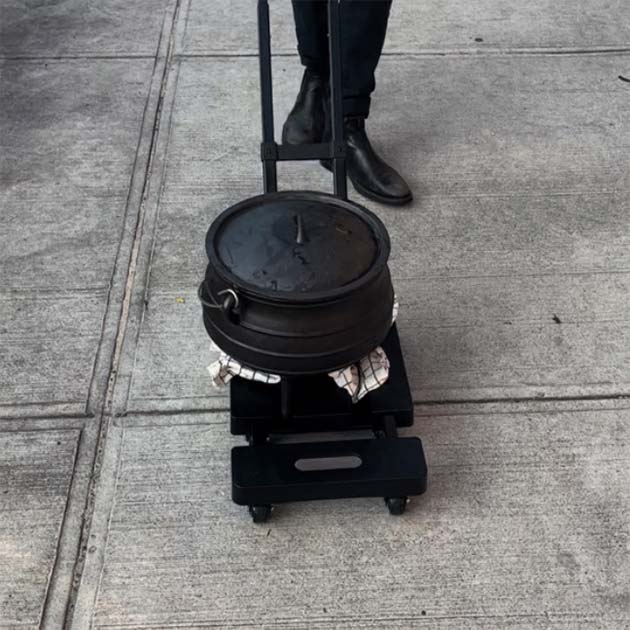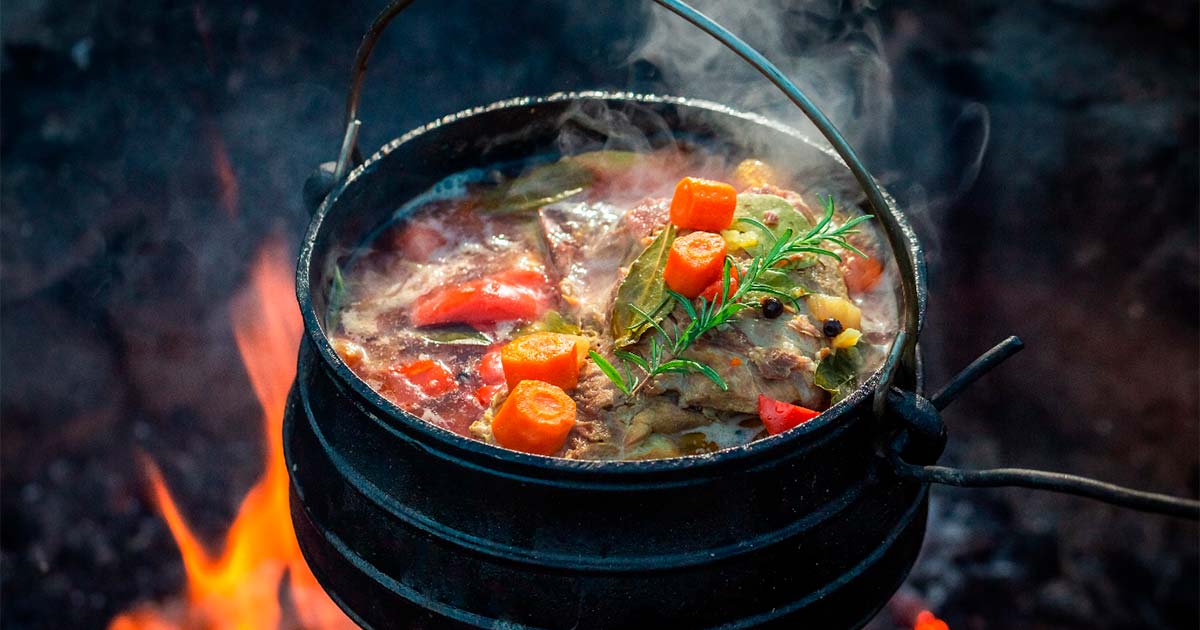What is this Ancient Perpetual Stew Being Served in a Brooklyn Park?
Most folk have experienced the holistic satisfaction that comes after a good old bowl of stew, on a cold winter’s nights. However, this story tips traditional stew conventions on their head, as it’s about a Tic Tok influencer who has New Yorkers gathering in a Brooklyn park to eat ‘really old’ stew, on hot summer nights.
Annie Rauwerda runs the Twitter and Tik Toc accounts “Depths of Wikipedia.” Last month Rauwerda posted a series of videos that went viral, based on the obscure headline: “have a perpetual stew summer.”
According to a report in the food magazine Delish, one post in particular featured the Wikipedia entry for “perpetual stew” which Rauwerda explained was also known as “hunter’s pot” or “hunter’s stew,” or by its modern, Americanized name, “forever soup”.

One day in the life of Brooklyn’s perpetual stew. Each day it is replenished with new ingredients. (Perpetualstewclub/CC BY-ND 2.5)
Forever Soup Served Beside Hell’s Kitchen
Essentially, hunter’s stew is a constantly simmering broth that ingredients are added to over time. An article about Annie Rauwerd’s hunter’s stew in the New York Post says these stews can “continue cooking for decades or longer, if properly maintained.” And to prove this point, Rauwerda told The Post that she began boiling a pan of potato leek soup on June 7, and it’s still simmering now, over a month later!
Rauwerda’s TikTok video has now been seen over 2 million times, and she is currently gathering a host of new “stew-friends” near Bushwick, in northern Brooklyn, to join what she calls (prepare to face palm) “the stew crew”.
But behind all this, lies a deeply ancient human tradition coming from a much older world, wherein nothing was ever discarded.

The Perpetual stew en route to the park in Brooklyn. (Perpetualstewclub/CC BY-ND 2.5)
Facts Fudged by the New Food Fad
When food fads such as these emerge from the pit of endless knowledge that is the internet, many reporters get excited and copy and paste the first thing they read to fill their articles. For example, in the Delish article it is claimed that the “origins of perpetual stew are largely believed to be in 14th century Poland, where stews were simmered for weeks on end.” But let’s dig deeper into the stew story.
According to Chat GPT, after being queried “where did stew originate'' in 10 different ways, it failed to answer. But it did offer information about the traditional Moroccan soup/stew made with meat, legumes, vegetables, and spices. Known as "Harira,” this is considered to be, by AI, “one of the oldest recorded stews in the world.”
To get to the real ancient origins of stews, we must go back thousands of years in time.
- Forget the Pig Roast, Anglo-Saxon Royalty Were Largely Vegetarian, Says Study
- A Test for the Taste Buds: The 7 Weirdest Foods in History
Stirring Up the Ancient Origins of Stew
It is quite challenging for the researcher to determine when exactly stew was first made. But archaeological discoveries have provided evidence of stew-like preparations having been cooked in clay pots dating back thousands of years. So far as written records go, according to an entry on “Historical Cooking classes,” around 1750 BC the ancient Akkadians of Mesopotamia (present-day Iraq) made meat and vegetable stews.
However, it has to be considered that with stew being so easy to make, cook and eat, it was probably a popular method of cooking throughout human history, from tens of thousands of years ago. Two examples of ancient clay bowls that may have been used for eating stew are the "Jomon pottery" of Japan dating back as early as 14,000 BC, and the "Hacilar pottery" unearthed in modern-day Turkey, that dates back to around 7,000 BC.
Would You Eat “300-Year-Old” Perpetual Stew?
The Post article tells the story of a Bangkok family who have been eating the same stew for 45 years, of Normandy’s pot-au-feu, that is recorded as having been stewed for “some 300 years.”
But returning to the Fermi Playground in Brooklyn, Annie Rauwerda has, via social media posts, invited the residents of Bushwick to bring down their “vegan ingredients” and to throw them in her cauldron.
The Post spoke with one local visitor, Joanna Gerber, 23, who said “everyone comes with a shared curiosity and mild amusement, with the intention of getting to know the other people who come.”
And for those readers worried about a potentially dire public health danger in all this eating of strangers scraps, Annie Rauwerda told The Post that the stew “is kept at 200 degrees Fahrenheit,” with only a small amount kept after a week to fuel the next batch.
New Yorker? Want Some Perpetual Stew Tonight?
The Tic-Tocker cooks her perpetual stew at 200 degrees because most food toxins are heat-sensitive, and are destroyed at temperatures above 165-176 degrees Fahrenheit (74-80 degrees Celsius). So, if you live in Brooklyn, and can get your head around a bowl of strangers’ scraps, cooked at 200 degrees, head on down to Fermi Playground at 7, for Rauwerda’s next perpetual stew event.
Top image: A perpetual stew or hunter’s stew, in a cauldron over an open fire. Source: shaiith/Adobe Stock
By Ashley Cowie

















